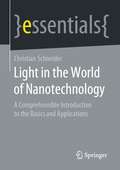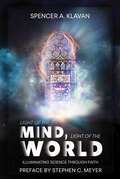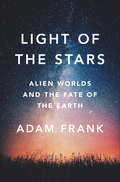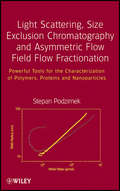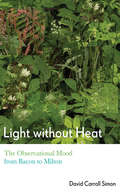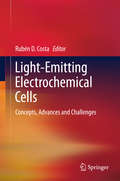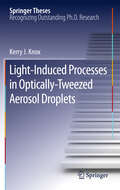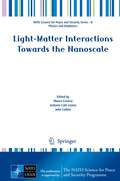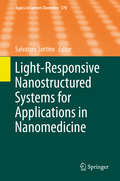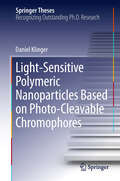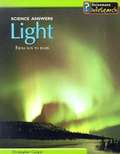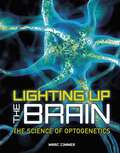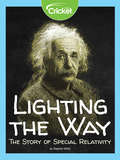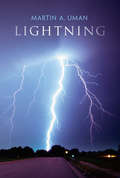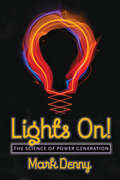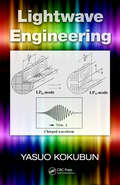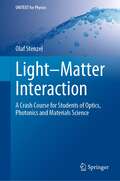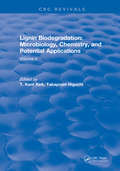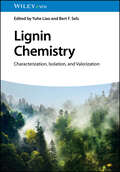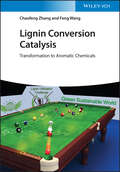- Table View
- List View
Light in the World of Nanotechnology: A Comprehensible Introduction to the Basics and Applications (essentials)
by Christian SchneiderThis essential gives an overview of the physical principles underlying nanotechnology, which today make it possible to use microscopic effects technologically. Methods are presented which allow the production of nanostructures with highest precision. In the last chapter the author gives an overview of exciting technological applications, starting with the use of nanotechnology-based effects in church glass windows to solar cells and CCD chips. This book is a translation of the original German 1st edition Licht in der Welt der Nanotechnologie by Christian Schneider, published by Springer Fachmedien Wiesbaden GmbH, part of Springer Nature in 2016. The translation was done with the help of artificial intelligence (machine translation by the service DeepL.com). A subsequent human revision was done primarily in terms of content, so that the book will read stylistically differently from a conventional translation. Springer Nature works continuously to further the development of tools for the production of books and on the related technologies to support the authors.
Light of the Mind, Light of the World: Illuminating Science Through Faith
by Spencer KlavanThe world is not a machine. Humanity is not a mistake. For centuries, a grim anti-human outlook has taken hold of the public imagination, teaching us all to view ourselves as random products of a cruel and uncaring natural world. Today, from apocalyptic environmentalism to twisted eugenics and dystopian bionic augmentation, movements are rising around the world to dispense with humanity or subordinate it to a pitiless mechanical logic. For many, it has come to seem as if the human spirit is obsolete, religious faith is illusory, and mankind is destined to be extinguished or surpassed. Some might even see the end of humanity as a good thing. But that is not our future. Light of the Mind, Light of the World tells a daring new story about how we got here, and how we can chart a better path forward. Surveying the history of science and faith from the astronomers of Babylon to the quantum physicists of postwar Europe and America, classicist and scholar Spencer A. Klavan argues that science itself is leading us not away from God but back to him, and to the ancient faith that places the human soul at the center of the universe. Reconciling the discoveries of science with the truths of the Bible, Klavan shows how the search for knowledge of the natural world can help illuminate the glories of its Creator, and how the latest developments in physics can help shatter the illusion of materialism.
Light of the Stars: Alien Worlds And The Fate Of The Earth
by Adam FrankAstrophysicist and NPR commentator on what the latest research on the existence and trajectories of alien civilizations may teach us about our own. Light of the Stars tells the story of humanity’s coming of age as we awaken to the possibilities of life on other worlds and their sudden relevance to our fate on Earth. Astrophysicist Adam Frank traces the question of alien life and intelligence from the ancient Greeks to the leading thinkers of our own time, and shows how we as a civilization can only hope to survive climate change if we recognize what science has recently discovered: that we are just one of ten billion trillion planets in the Universe, and it’s highly likely that many of those planets hosted technologically advanced alien civilizations. What’s more, each of those civilizations must have faced the same challenge of civilization-driven climate change. Written with great clarity and conviction, Light of the Stars builds on the inspiring work of pioneering scientists such as Frank Drake and Carl Sagan, whose work at the dawn of the space age began building the new science of astrobiology; Jack James, the Texas-born engineer who drove NASA’s first planetary missions to success; Vladimir Vernadsky, the Russian geochemist who first envisioned the Earth’s biosphere; and James Lovelock and Lynn Margulis, who invented Gaia theory. Frank recounts the perilous journey NASA undertook across millions of miles of deep space to get its probes to Venus and Mars, yielding our first view of the cosmic laws of planets and climate that changed our understanding of our place in the universe. Thrilling science at the grandest of scales, Light of the Stars explores what may be the largest question of all: What can the likely presence of life on other worlds tell us about our own fate?
Light scattering, size exclusion chromatography and asymmetric flow field flow fractionation
by Stepan PodzimekA comprehensive, practical approach to three powerful methods of polymer analysis and characterization This book serves as a complete compendium of three important methods widely used for the characterization of synthetic and natural polymers--light scattering, size exclusion chromatography (SEC), and asymmetric flow field flow fractionation (A4F). Featuring numerous up-to-date examples of experimental results obtained by light scattering, SEC, and A4F measurements, Light Scattering, Size Exclusion Chromatography and Asymmetric Flow Field Flow Fractionation takes an all-in-one approach to deliver a complete and thorough explanation of the principles, theories, and instrumentation needed to characterize polymers from the viewpoint of their molar mass distribution, size, branching, and aggregation. This comprehensive resource: Is the only book gathering light scattering, size exclusion chromatography, and asymmetric flow field flow fractionation into a single text Systematically compares results of size exclusion chromatography with results of asymmetric flow field flow fractionation, and how these two methods complement each other Provides in-depth guidelines for reproducible and correct determination of molar mass and molecular size of polymers using SEC or A4F coupled with a multi-angle light scattering detector Offers a detailed overview of the methodology, detection, and characterization of polymer branching Light Scattering, Size Exclusion Chromatography and Asymmetric Flow Field Flow Fractionation should be of great interest to all those engaged in the polymer analysis and characterization in industrial and university research, as well as in manufacturing quality control laboratories. Both beginners and experienced can confidently rely on this volume to confirm their own understanding or to help interpret their results.
Light to Life: The miracle of photosynthesis and how it can save the planet
by Raffael Jovine"Read this book and you will learn how photosynthesis was discovered, how it works, and how we can produce more food to feed the world." - PAUL NURSE, Nobel Prize winner and author of What is Life?In Light to Life, biologist Raffael Jovine takes us on a journey of discovery into the intricate, beautiful and often surprising processes that convert energy from the sun into life and how all-important these are to our survival.Despite the unprecedented challenges the Earth faces from global warming, habitat loss, air pollution and population growth; Jovine shows us that there is hope to be found. Photosynthesis is the very source of life: it has the power not just to produce food, but to reshape continents, drive biogeochemical cycles, stabilise the climate and regulate weather.In this exciting, revelatory book, Jovine unveils a blueprint for the future: greening the desert, bringing the ocean on land, planting mangrove forests and oyster banks, growing algae for animal feed, human food and soil carbon... He demonstrates how by harnessing photosynthesis we can regenerate the planet and revise the way we human beings interact with it.This book will help you to see the world in a different way, in all its wonderful detail - through the photosynthetic pigments in your eyes.
Light without Heat: The Observational Mood from Bacon to Milton
by David Carroll SimonIn Light without Heat, David Carroll Simon argues for the importance of carelessness to the literary and scientific experiments of the seventeenth century. While scholars have often looked to this period in order to narrate the triumph of methodical rigor as a quintessentially modern intellectual value, Simon describes the appeal of open-ended receptivity to the protagonists of the New Science. In straying from the work of self-possession and the duty to sift fact from fiction, early modern intellectuals discovered the cognitive advantages of the undisciplined mind.Exploring the influence of what he calls the "observational mood" on both poetry and prose, Simon offers new readings of Michel de Montaigne, Francis Bacon, Izaak Walton, Henry Power, Robert Hooke, Robert Boyle, Andrew Marvell, and John Milton. He also extends his inquiry beyond the boundaries of early modernity, arguing for a literary theory that trades strict methodological commitment for an openness to lawless drift.
Light-Emitting Electrochemical Cells
by Rubén D. CostaThis book presents the recent achievements towards the next generation of Light-emitting electrochemical cells (LEC). Its first part focus on the definition, history and mechanism of LEC, going then to concepts and challenges and, finally, giving the reader examples of current application of new electroluminescent materials. The chapters are written by different international groups working on LEC.
Light-Induced Processes in Optically-Tweezed Aerosol Droplets
by Kerry J. KnoxAerosols play a critical role in a broad range of scientific disciplines, such as atmospheric chemistry and physics, combustion science, drug delivery and human health. This thesis explores the fundamentals of a new technique for capturing single or multiple particles using light, and for characterising these particles by Raman or fluorescence spectroscopy. The outcome of this research represents a significant development in optical manipulation techniques, specifically in optical tweezing. These findings can be applied to studies of the mass accommodation of gas-phase water molecules adsorbing onto a water surface. Not only is this a fundamental process of interest to physical chemists, but it is important for understanding the role of aerosol particles in the atmosphere, including their ability to become cloud droplets. This new strategy for investigating aerosol dynamics is fundamental in helping us understand the indirect effect of aerosols on the climate.
Light-Matter Interactions Towards the Nanoscale (NATO Science for Peace and Security Series B: Physics and Biophysics)
by John Collins Maura Cesaria Antonio Calà LesinaThe investigation of light-matter interactions in materials, especially those on the nanoscale, represents perhaps the most promising avenue for scientific progress in the fields of photonics and plasmonics. This book examines a variety of topics, starting from fundamental principles, leading to the current state of the art research. For example, this volume includes a chapter on the sensing of biological molecules with optical resonators (microspheres) combined with plasmonic systems, where the response this system are described in a fundamental and elegant manner using coupled mode theory. Symmetry plays a major role in the book. One chapter on time reversal symmetry in electromagnetic theory describes how to control the properties of light (e.g. scattering and directionality of the flow of light) in materials with certain topological invariants. Another chapter where symmetry is prominent reformulates, using a gentle and pedagogical approach, Maxwell’s Equations into a new set of fields that reveal a “handedness” symmetry in electromagnetic theory, which can be applied to photonic systems in, for example, the sensing of chiral molecules and understanding the conditions for zero reflection. Also, for students and researchers starting in the field of nanoplasmonics, the book includes a tutorial on the finite element time domain simulation of nanoplasmonic systems. Other topics include photonic systems for quantum computing, nanoplasmonics, and optical properties of nano and bulk materials. The authors take a pedagogical approach to their topic, making the book an excellent reference for graduate students and scientists starting in the fields of photonics or plasmonics.
Light-Responsive Nanostructured Systems for Applications in Nanomedicine
by Salvatore SortinoThe series Topics in Current Chemistry presents critical reviews of the present and future trends in modern chemical research. The scope of coverage is all areas of chemical science including the interfaces with related disciplines such as biology, medicine and materials science. The goal of each thematic volume is to give the non-specialist reader, whether in academia or industry, a comprehensive insight into an area where new research is emerging which is of interest to a larger scientific audience. Each review within the volume critically surveys one aspect of that topic and places it within the context of the volume as a whole. The most significant developments of the last 5 to 10 years are presented using selected examples to illustrate the principles discussed. The coverage is not intended to be an exhaustive summary of the field or include large quantities of data, but should rather be conceptual, concentrating on the methodological thinking that will allow the non-specialist reader to understand the information presented. Contributions also offer an outlook on potential future developments in the field. Review articles for the individual volumes are invited by the volume editors. Readership: research chemists at universities or in industry, graduate students.
Light-Sensitive Polymeric Nanoparticles Based on Photo-Cleavable Chromophores
by Daniel KlingerThe triggered release of functional compounds from such polymeric carriers as micelles, nanoparticles or nanogels is a rapidly developing and highly versatile concept which is expected to be one of the key approaches to future therapeutics. In his thesis, Daniel Klinger highlights the approach of stimuli-responsive microgels for such applications and discusses why especially light as a trigger has an outstanding position amongst the family of conventional stimuli. Based on these considerations, the author focuses on the design, synthesis and characterization of novel photo-sensitive microgels and nanoparticles as potential materials for the loading and light-triggered release/accessibility of functional compounds. Starting from the synthesis of photo-cleavable organic building blocks and their use in the preparation of polymeric nanoparticles, continuing to the examination of their loading and release profiles, and concluding with biological in vitro studies of the final materials, Daniel Klinger's work is an excellent example of the multidisciplinary research needed for the successful development of new materials in this field and has led to a number of further publications in internationally respected journals.
Light: From Sun to Bulbs
by Christopher CooperWhat is light? Why do we see different colors? Why we appear upside down in some mirrors? Investigate the dazzling world of physical science! Find out for yourself about light through experiments that you can do at home. Did you know that white light is made up of many colors? Light will show you the importance of investigating and understanding the physical world around you.
Light: Physical Science)
by Adele D. RichardsonProvides an introduction to light, including its components, forms, and movement, as well as humans' perception of light.
Lighthouse Tales
by Frederick StonehouseFrom the Book Jacket: Lighthouse Tales tells the story of the exciting human side of lightkeeping. It describes the deadly storms, killing fogs and numbing loneliness those who "kept the lights" endured. Stories of wreck and rescue, death and sacrifice, all thread their way through the pages of this remarkable tribute to the "wickies" of a bygone era. The book speaks of the courage of the old time keepers and their families, not just in rescuing shipwreck victims but also in the tenacity of their daily lives. Lighthouse Tales will appeal greatly to anyone interested in the wonders of the Great Lakes, historians, sailors, lighthouse fanatics and people just looking for a roaring good story. The book is thoroughly illustrated with rare photographs. Narratives include: The thrilling story of the steamer GEORGE W. PERKINS and it's close encounter with Lansing Shoal Light during the height of the infamous 1940 Armistice Day storm. Superior Shoal and the lighthouse that wasn't. The death of six brave Coast Guardsmen at Oswego, New York in 1942. Poverty Island Light and the mysterious treasure. And many more thrilling tales of "keeping the lights!"
Lighting Up the Brain: The Science of Optogenetics
by Marc ZimmerWhat if neuroscientists could look inside the human brain and watch individual brain cells send signals to one another? What if they could then control these brain cells to direct thoughts and actions? This may sound like science fiction, but it's actually a scientific revolution called optogenetics. Neuroscientists would like to use this new technology on human brains to uncover secrets about how the brain processes information and drives human behavior. Doctors hope to use optogenetics to restore sight and to treat Alzheimer's disease, Parkinson's disease, depression, and other debilitating or deadly health problems. Discover how the innovative work of leaders in the field is poised to radically transform science, medicine, and human health.
Lighting the Way: The Story of Special Relativity
by Stephen WhittWhat is a light beam? What are photon particles? What are all things made of? These are questions young Einstein asked himself; questions that would change our world forever. Travel along with young Einstein to learn about his discoveries, still in motion today!
Lightning
by Vladimir A. Rakov Martin A. UmanComplete and comprehensive, this text for advanced undergraduates in physics and engineering features exceptional clarity and minimum of mathematic notation. Topics include lightning phenomena and terminology, lightning photography, lightning spectroscopy, electrical and magnetic field measurements and current measurements, and more. 140 figures and tables.
Lightning: Fire From The Sky (Dover Books on Physics #Volume 39)
by Martin A. UmanAwesome to any beholder, lightning has been a subject of intense interest to scientists curious about its exact physical nature. There was a dearth of comprehensive scientific literature on the subject until the publication of this volume. Geared toward advanced undergraduates in physics or engineering, it features remarkable clarity and a minimum of mathematical notation, making it accessible to nonspecialists and useful as a teaching resource or for self-study. Dr. Uman, whose own work has contributed greatly to understanding the physics of lightning, presents a general introduction to lightning phenomena and terminology, lightning photography, electrical and magnetic field measurements, and current measurements. Additional topics include lightning spectroscopy and thunder, a wealth of new and detailed analyses of the latest data, and reviews of theories regarding the discharge process from the special vantage point of a scientist well-versed in plasma physics. Five appendices bring recent research up to date, covering such phenomena as bead and ball lightning and reviewing experimental data and modeling. This authoritative exposition of the many physical phenomena associated with lightning is the only inexpensive single-volume presentation on the subject.
Lights On!: The Science of Power Generation
by Mark DennyWatt’s up? A reader-friendly introduction to all things power.Power generation is a relatively recent concern because humans had little need for sustained power until the dawn of the Industrial Revolution. Today, modern civilization is wholly dependent on the production and distribution of power. Without it, our way of life would be extinguished.In Lights On!, Mark Denny reveals the mysterious world of power generation. He takes us on a fun tour, examining the nature of energy, tracing the history of power generation, explaining the processes from production through transmission to use, and addressing questions that are currently in the headlines, such as:• Is natural gas the best alternative energy source in the near term? • Could solar power be the answer to all our problems? • Why is nuclear power such a hard sell, and are the concerns valid?Devoting individual chapters to each of the forms of power in use today—electrical, coal, oil and natural gas, hydro, nuclear, and solar—Denny explains the pros and cons of each, their availability worldwide, and which are in dwindling supply. Making clear that his approach is that of "a scientist and engineer, not a politician or businessman," Denny addresses environmental concerns by providing information to help readers understand the science and engineering of power generation so they can discuss contemporary energy issues from an informed perspective. For those who wish to delve deeper into the science, a technical appendix provides estimations for a variety of power generators.Anyone who is interested in how energy works and how it is transformed to power our lives will get a charge out of Lights On!
Lightwave Engineering (Optical Science and Engineering)
by Yasuo KokubunSuitable as either a student text or professional reference, Lightwave Engineering addresses the behavior of electromagnetic waves and the propagation of light, which forms the basis of the wide-ranging field of optoelectronics. Divided into two parts, the book first gives a comprehensive introduction to lightwave engineering using plane wave and then offers an in-depth analysis of lightwave propagation in terms of electromagnetic theory. Using the language of mathematics to explain natural phenomena, the book includes numerous illustrative figures that help readers develop an intuitive understanding of light propagation. It also provides helpful equations and outlines their exact derivation and physical meaning, enabling users to acquire an analytical understanding as well. After explaining a concept, the author includes several problems that are tailored to illustrate the explanation and help explain the next concept. The book addresses key topics including fundamentals of interferometers and resonators, guided wave, optical fibers, and lightwave devices and circuits. It also features useful appendices that contain formulas for Fourier transform, derivation of Green's theorem, vector algebra, Gaussian function, cylindrical function, and more. Ranging from basic to more difficult, the book’s content is designed for easily adjustable application, making it equally useful for university lectures or a review of basic theory for professional engineers.
Light–Matter Interaction: A Crash Course for Students of Optics, Photonics and Materials Science (UNITEXT for Physics)
by Olaf StenzelThis book offers a didactic introduction to light–matter interactions at both the classical and semi-classical levels. Pursuing an approach that describes the essential physics behind the functionality of any optical element, it acquaints students with the broad areas of optics and photonics. Its rigorous, bottom-up approach to the subject, using model systems ranging from individual atoms and simple molecules to crystalline and amorphous solids, gradually builds up the reader’s familiarity and confidence with the subject matter. Throughout the book, the detailed mathematical treatment and examples of practical applications are accompanied by problems with worked-out solutions. In short, the book provides the most essential information for any graduate or advanced undergraduate student wishing to begin their course of study in the field of photonics, or to brush up on important concepts prior to an examination.
Lignin Biodegradation: Volume I
by T.K. KirkFirst Published in 2018. Routledge is an imprint of Taylor & Francis, an Informa company.
Lignin Biodegradation: Volume II
by T.Kent. KirkLignin is a generic name for the complex aromatic polymers that are major components of vascular plant tissues. Lignin is abundant; in terms of weight it is probably second only to cellulose among renewable organic materials, and in terms of energy content it might well be the single most abundant. an international seminar on lignin biodegradation was organized and was held May 9 to 11, 1978, at the U.S. Forest Products Laboratory in Madison, Wisconsin. This book records the proceedings of that seminar and is meant to provide a summary of research. Each speaker/author was asked to summarize his research, including his latest unpublished results, and to describe how his work fits into the overall picture. Following two orientation chapters, one a review of lignin structure and morphological distribution in plant cell walls, and the second a review of the microbial catabolism of relevant aromatics, the book is comprised of chapters in the three subject areas given by the book's title. It does, as intended, provide comprehensive coverage of research to date (August 1978).
Lignin Chemistry: Characterization, Isolation, and Valorization
by Bert F. Sels Yuhe LiaoLignin Chemistry A thorough reference guide to Lignin Chemistry, from inherent structure revealing to transformation into chemicals, fuels, and materials Climate change, driven by rising greenhouse gas emissions, is the defining challenge of our time. Reducing our dependence on non-renewable resources such as fossil fuels will require alternative, more sustainable resources. Lignin, the only widely-occurring, renewable, aromatic bio-polymer in Nature, has a range of application potential in the production of chemicals, fuels, and other industrial materials. Lignin science has become one of the fastest-growing and most significant areas of sustainable chemistry in the world. Lignin Chemistry: Characterization, Isolation, and Valorization presents a systematic, multidisciplinary overview of this cutting-edge field and its current state of research. Beginning with a robust characterization of lignin, the book addresses the isolation and transformation of lignin, as well as the book inspires with a plethora of applications. The result is a critical resource for researchers and professionals in any area of academic or industry where renewable biomass, in particular lignin, has importance. Lignin Chemistry readers will find: Thermochemical and catalytic strategies for lignin conversionDetailed discussion of the valorization of lignin towards biopolymers, nanoparticles, carbon fibers and materials, and hydrogelsAn authorial team with immense and varied research experience Lignin Chemistry is ideal for chemical engineers, catalytic chemists, biochemists, material scientists, and analytical chemists in industry.
Lignin Conversion Catalysis: Transformation to Aromatic Chemicals
by Feng Wang Chaofeng ZhangLignin Conversion Catalysis Authoritative reference providing comprehensive knowledge on the lignin conversion process with recent developments of mechanisms and techniques Lignin Conversion Catalysis: Transformation to Aromatic Chemicals covers the strategy, catalysis, and mechanisms of cleaving lignin linkages to aromatic chemicals and crucially elaborates on the specifics of multiple original lignins. Sample topics covered in the work include: Lignin depolymerization, models, and techniques of various lignins by heterogeneous substrates (such as native lignins, Kraft lignins, and organosolv lignins) Cleavage methods for lignins (such as oxidation and hydrogenation) as well as their main products (such as arenes, phenol, and acid) Relationships among the strategy/method, catalyst, and mechanism when viewed from the cleavage order and the type of corresponding chemical bonds Commercial components of lignin, a globally available raw material with many applications in drug design, polymers, and more Organic chemists, polymer chemists, and chemical engineers can use the valuable information contained in Lignin Conversion Catalysis: Transformation to Aromatic Chemicals to get up to date on this new raw material and understand the various developments that have been made in the field to make it viable for industrial purposes.
